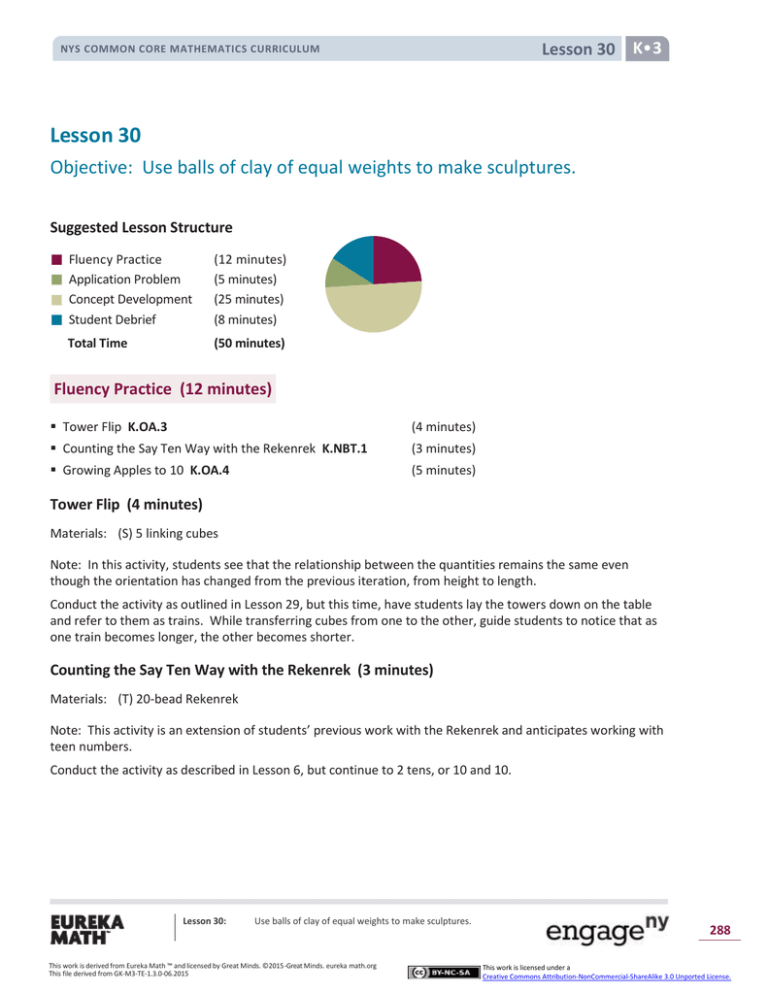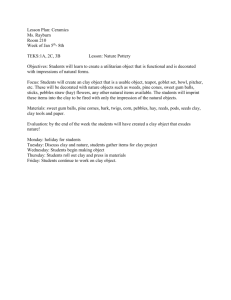Lesson 30 - EngageNY
advertisement

Lesson 30 K•3 NYS COMMON CORE MATHEMATICS CURRICULUM Lesson 30 Objective: Use balls of clay of equal weights to make sculptures. Suggested Lesson Structure Fluency Practice Application Problem Concept Development Student Debrief Total Time (12 minutes) (5 minutes) (25 minutes) (8 minutes) (50 minutes) Fluency Practice (12 minutes) Tower Flip K.OA.3 (4 minutes) Counting the Say Ten Way with the Rekenrek K.NBT.1 (3 minutes) Growing Apples to 10 K.OA.4 (5 minutes) Tower Flip (4 minutes) Materials: (S) 5 linking cubes Note: In this activity, students see that the relationship between the quantities remains the same even though the orientation has changed from the previous iteration, from height to length. Conduct the activity as outlined in Lesson 29, but this time, have students lay the towers down on the table and refer to them as trains. While transferring cubes from one to the other, guide students to notice that as one train becomes longer, the other becomes shorter. Counting the Say Ten Way with the Rekenrek (3 minutes) Materials: (T) 20-bead Rekenrek Note: This activity is an extension of students’ previous work with the Rekenrek and anticipates working with teen numbers. Conduct the activity as described in Lesson 6, but continue to 2 tens, or 10 and 10. Lesson 30: Use balls of clay of equal weights to make sculptures. This work is derived from Eureka Math ™ and licensed by Great Minds. ©2015 -Great Minds. eureka math.org This file derived from GK-M3-TE-1.3.0-06.2015 288 This work is licensed under a Creative Commons Attribution-NonCommercial-ShareAlike 3.0 Unported License. Lesson 30 K•3 NYS COMMON CORE MATHEMATICS CURRICULUM Growing Apples to 10 (5 minutes) Materials: (S) Apple mat (Fluency Template), 10 red beans, die with 6-dot side covered Note: This activity gives students a head start in learning partners to ten, anticipating the work of the next module. 1. 2. 3. 4. 5. 6. Roll the die. Put that many red beans on the apple tree, arranging them in 5-groups. Count how many more are needed to make 10. Say, “I have ____. I need _____ more to make 10.” Do not remove the beans. Roll the die again. Count to see if there are enough spaces for that many beans. (If the number goes over 10, and there aren’t enough spaces, simply roll again to get a smaller number.) Then, place that many beans on the apple tree. State the new amount and how many more it needs to make 10. Continue until 10 is made. Then, remove the beans, and start again from 0 if time permits. This game can also be played with a partner. A spinner can be used instead of a die. Application Problem (5 minutes) Imagine a balance scale. Can you see it? Now, imagine putting one big ball of clay on one side and four small balls of clay on the other. If the big ball is as heavy as the four small balls put together, then what would the balance scale look like? Draw it. Note: In this problem, we turn the thinking around to ask the students to consider and demonstrate what they know about the conservation of weight. Circulate during the discussion to ensure understanding of the question and to see if students are creating reasonably sized balls for the comparison. Encourage correct mathematical vocabulary. Lesson 30: NOTES ON MULTIPLE MEANS OF REPRESENTATION: Give English language learners and students working below grade level a graphic that includes a picture of a balance scale to help them understand what is being asked. Remind them how the balance scale looks when two objects are the same weight. The visual helps students demonstrate that the balance is even or level. Check students’ learning by asking them to explain what it means when the balance scale is balanced. NOTES ON MULTIPLE MEANS OF ENGAGEMENT: Ask students working above grade level to explain why the differently shaped objects made with the clay still weigh the same when placed on the balance scale. Ask them how they would go about proving their thinking to an alien who just landed on earth. Use balls of clay of equal weights to make sculptures. This work is derived from Eureka Math ™ and licensed by Great Minds. ©2015 -Great Minds. eureka math.org This file derived from GK-M3-TE-1.3.0-06.2015 289 This work is licensed under a Creative Commons Attribution-NonCommercial-ShareAlike 3.0 Unported License. NYS COMMON CORE MATHEMATICS CURRICULUM Lesson 30 K•3 Concept Development (25 minutes) Materials: (S) Balance scale, 2 small pieces of clay per pair of partners (different color clays, but equal weight), clay shapes recording sheet (Template) Note: Save a piece of clay for the culminating task in Lesson 32. T: S: T: S: T: S: T: S: T: S: T: MP.2 Work with your partner. Test your pieces of clay on your balance scale. What do you notice? They are the same weight. It balances! With all of your blue clay, make a snake as long as your pinky finger. With all of your red clay, make a snake as long as your thumb. What do you notice? The red snake is longer than the blue. The blue snake is fatter. Test your snakes on the balance. They weigh the same! What is the same about them? They’re the same weight. Now, make a little bowl with your blue clay. On your Recording Sheet, pick a frame. In that frame, draw a picture of your bowl. Make a cup with your red clay. Draw a picture of your cup in another frame. Now, test them on your balance. It still balances. This one looks bigger, but it still weighs the same as the other one. Hmm. I wonder which of your clay containers would hold more? (Allow time for discussion and sharing.) Continue the lesson, experimenting and recording results with other shapes and configurations: flatter and taller, wider and narrower, thinner and fatter, and so on. Lead the children to discover that the weight is constant regardless of the configuration of the clay. T: Now, make your favorite indoor animal with the blue clay, and draw it on your Recording Sheet. Make your favorite outdoor animal with the red clay, and draw it on your Recording Sheet. Can you make a guess about their weights? Talk about your guess with your partner. Now, test your guess! Problem Set In this lesson, the clay shapes recording sheet serves as the Problem Set for the Concept Development. Lesson 30: Use balls of clay of equal weights to make sculptures. This work is derived from Eureka Math ™ and licensed by Great Minds. ©2015 -Great Minds. eureka math.org This file derived from GK-M3-TE-1.3.0-06.2015 290 This work is licensed under a Creative Commons Attribution-NonCommercial-ShareAlike 3.0 Unported License. NYS COMMON CORE MATHEMATICS CURRICULUM Lesson 30 K•3 Student Debrief (8 minutes) Lesson Objective: Use balls of clay of equal weights to make sculptures. The Student Debrief is intended to invite reflection and active processing of the total lesson experience. Invite students to compare their recording sheets with a partner before reviewing as a class. Look for misconceptions or misunderstandings that can be addressed in the Debrief. Any combination of the questions below may be used to lead the discussion. When you compared your clay with your partner’s, did you expect them to weigh the same? Why or why not? What did you learn when you and your partner made snakes and compared their weights? Were you surprised with the results? Did this change your thinking? (Observe student responses to see who has a grasp of the conservation of weight.) What happened to the weight of your clay when you created a new object? Was this a surprise to you, or did you expect your clay to weigh the same? How did the Application Problem connect to today’s lesson? Lesson 30: Use balls of clay of equal weights to make sculptures. This work is derived from Eureka Math ™ and licensed by Great Minds. ©2015 -Great Minds. eureka math.org This file derived from GK-M3-TE-1.3.0-06.2015 291 This work is licensed under a Creative Commons Attribution-NonCommercial-ShareAlike 3.0 Unported License. NYS COMMON CORE MATHEMATICS CURRICULUM Lesson 30 Homework K•3 Dear Parents: In class, we used balls of clay that weigh the same on the balance scale to make different sculptures. We saw that the same balls of clay can take various forms without changing the weight. The balls weighed the same on the balance scale, as did the sculptures. Today’s homework is a review of fluency work. Lesson 30: Use balls of clay of equal weights to make sculptures. This work is derived from Eureka Math ™ and licensed by Great Minds. ©2015 -Great Minds. eureka math.org This file derived from GK-M3-TE-1.3.0-06.2015 292 This work is licensed under a Creative Commons Attribution-NonCommercial-ShareAlike 3.0 Unported License. NYS COMMON CORE MATHEMATICS CURRICULUM Name Lesson 30 Homework K•3 Date Lesson 30: Use balls of clay of equal weights to make sculptures. This work is derived from Eureka Math ™ and licensed by Great Minds. ©2015 -Great Minds. eureka math.org This file derived from GK-M3-TE-1.3.0-06.2015 293 This work is licensed under a Creative Commons Attribution-NonCommercial-ShareAlike 3.0 Unported License. NYS COMMON CORE MATHEMATICS CURRICULUM Lesson 30 Fluency Template K•3 apple mat Lesson 30: Use balls of clay of equal weights to make sculptures. This work is derived from Eureka Math ™ and licensed by Great Minds. ©2015 -Great Minds. eureka math.org This file derived from GK-M3-TE-1.3.0-06.2015 294 This work is licensed under a Creative Commons Attribution-NonCommercial-ShareAlike 3.0 Unported License. NYS COMMON CORE MATHEMATICS CURRICULUM Name Date Lesson 30 Template K•3 Clay Shapes clay shapes recording sheet Lesson 30: Use balls of clay of equal weights to make sculptures. This work is derived from Eureka Math ™ and licensed by Great Minds. ©2015 -Great Minds. eureka math.org This file derived from GK-M3-TE-1.3.0-06.2015 295 This work is licensed under a Creative Commons Attribution-NonCommercial-ShareAlike 3.0 Unported License.







